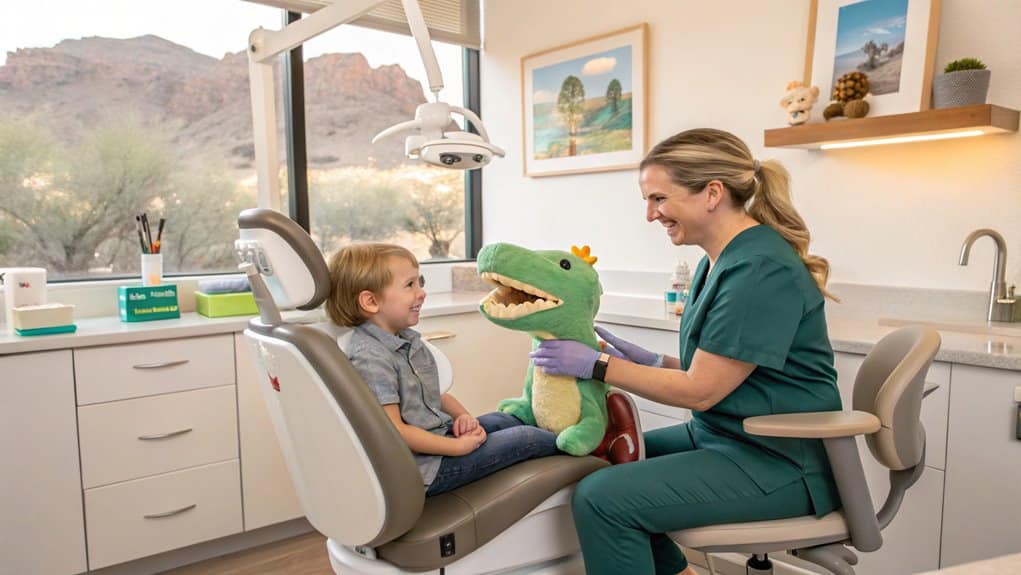What Steps Should Scottsdale Parents Take to Prepare Their Children for Restorative Dental Visits?
Quick Take: Preparing children for restorative dental visits in Scottsdale involves reducing anxiety, fostering positive habits, and choosing specialized care to ensure a smooth experience.
For many Scottsdale parents, restorative dental care for children can feel overwhelming—especially when anxiety and cooperation become challenges. Kids who are unfamiliar with dental procedures often experience fear, which can make treatment more difficult and impact their long-term oral health. Preparing them ahead of time helps ease these worries and fosters trust before the appointment.
Parents can make dental visits less intimidating through playful learning, such as role-play, storybooks, or kid-friendly videos that explain what to expect. Establishing consistent at-home routines and choosing a board-certified pediatric dentist skilled in behavioral management further support a positive experience. Understanding available sedation options also helps parents make informed choices, ensuring a safe, comfortable, and successful visit for their child.
Key Takeaways
- Use role-play with dental toys and books at home to help children get familiar with common procedures and instruments before their appointment.
- Arrange a pre-appointment visit to the dental office so your child can explore the environment and feel more at ease.
- Practice simple deep breathing and relaxation techniques with your child to support managing any anxiety during dental visits.
- Select a pediatric dentist who is board-certified and experienced in child-friendly communication and behavior guidance.
- Apply the tell-show-do approach at home by explaining dental procedures in language your child can easily understand, demonstrating each step when possible.
Pre-Visit Strategies for Reducing Dental Anxiety
Key Insight: Effective pre-visit preparation sets the stage for a smoother dental experience by familiarizing children with dental environments and procedures. These strategies help mitigate fear responses by building a sense of control and predictability around dental care.
Equipping children with calming tools and knowledge empowers them to approach dental visits with confidence, reducing behavioral challenges and enhancing treatment outcomes. Additionally, many pediatric practices, such as Palm Valley Pediatric Dentistry & Orthodontics, focus on creating fun, educational experiences to reduce anxiety during consultations.
Parents can leverage diverse educational and experiential methods to create a supportive atmosphere before the appointment. Integrating role-play, multimedia resources, and observational learning nurtures familiarity and emotional readiness. Children develop trust in the dental process, which is critical for sustained oral health engagement and positive reinforcement during complex restorative treatments.
Effective pre-visit preparation includes:
- Dental role-play with toys to demystify instruments and procedures in a stress-free setting.
- Calming techniques training, such as deep breathing and progressive muscle relaxation, to manage in-the-moment anxiety.
- Age-appropriate multimedia resources, including books, videos, and apps that explain treatments in child-friendly language.
- Tell-show-do methodology that sequentially introduces each step of the dental visit to build understanding and reduce uncertainty.
- Observational learning opportunities, where children watch siblings or peers undergo dental care to normalize the experience.
Embracing comprehensive pre-visit strategies transforms dental appointments from intimidating events into manageable, even empowering experiences. That’s why caregivers who proactively prepare their children help cultivate lifelong positive attitudes toward oral health. Integrating these techniques consistently can lead to improved cooperation, reduced anxiety, and better clinical outcomes during restorative dental visits.
Creating a Positive Dental Environment at Home
Key Insight: Establishing a nurturing dental environment at home lays the groundwork for lifelong oral health habits by fostering familiarity, confidence, and positive associations with dental care routines. Engaging children through interactive play and consistent practices supports both emotional comfort and practical skill development.
Incorporating educational and enjoyable elements into daily oral hygiene routines transforms dental care from a chore into a meaningful experience. Children are more likely to embrace regular brushing, understand dental health concepts, and approach dental visits without fear or resistance, reinforcing preventive care and reducing anxiety.
Effective strategies to cultivate a positive home dental environment include:
- Utilizing dental toy kits and role-playing with dolls or stuffed animals to demystify dental instruments and procedures.
- Creating storytelling rituals around toothbrushing that connect oral hygiene with bedtime routines for better retention.
- Designing a dedicated dental corner stocked with age-appropriate educational materials and colorful, child-friendly oral care products.
- Implementing timers, favorite songs, and visually appealing dental accessories to make brushing engaging and consistent.
- Modeling exemplary dental behaviors and offering positive reinforcement to encourage motivation and healthy attitudes toward oral care.
Additionally, parents can consider creating anxiety-free environments during dental visits, as this approach ensures children feel more comfortable and secure while receiving care. These intentional actions build a resilient foundation for children’s oral wellness by integrating emotional reassurance with evidence-based hygiene habits. That’s why prioritizing a supportive, educational, and fun dental atmosphere at home empowers parents to shape confident, proactive young patients who value their oral health. Families can leverage these approaches to not only prevent dental issues but also instill a lifelong commitment to maintaining a healthy smile.
Choosing the Right Pediatric Dental Team
Key Insight: Choosing the right pediatric dental team is crucial for your child’s long-term oral health, combining expert care with a supportive, child-centered environment. This decision impacts not only treatment outcomes but also your child’s comfort and trust in dental visits, setting the foundation for lifelong dental wellness.
Parents should prioritize pediatric dentists with board certification and advanced training focused on children’s unique dental needs, including preventive care, restorative treatments, and behavioral management. A comprehensive dental team will integrate child-friendly technology, empathetic communication, and collaboration with insurance providers to ensure accessible, personalized care tailored to each young patient’s needs.
To ensure optimal pediatric dental care, consider these key factors when selecting a dental team:
- Specialized Credentials: Board-certified pediatric dentists with recognized expertise in child oral health and developmental dentistry.
- Child-Centered Environment: Clinics equipped with ergonomic, age-appropriate dental tools and calming, engaging waiting areas.
- Behavioral Expertise: Proven techniques in managing dental anxiety and fostering positive patient experiences through empathetic communication.
- Insurance Coordination: Transparent handling of diverse pediatric dental insurance plans and flexible payment options.
- Accessibility: Convenient office location combined with adaptable scheduling to accommodate family routines.
- Community Reputation: Positive reviews and referrals that reflect consistent clinical excellence and trusted patient relationships.
Additionally, it is beneficial to select a dental team that offers advanced technology such as digital imaging and laser dentistry to enhance the quality of care. Selecting a pediatric dental team that balances clinical proficiency with compassionate care cultivates your child’s confidence and cooperation during dental visits. Parents can feel assured their child’s oral health is nurtured in a safe, welcoming environment that emphasizes prevention and education. That’s why investing time in evaluating these multidimensional factors leads to healthier smiles and enduring trust between families and their dental professionals.
Understanding Sedation and Comfort Options
Key Insight: Most children do well with minimal sedation during dental care, with nitrous oxide as the preferred method for gentle anxiety relief and only a small fraction requiring stronger sedation options.
When managing pediatric dental anxiety, understanding sedation choices is essential for parents and caregivers. Advances in sedation techniques have made dental visits safer and more comfortable, reducing stress for young patients. Most children respond well to non-invasive calming methods, making sedation unnecessary in the majority of cases. That’s why dental professionals emphasize tailored approaches that prioritize safety and patient comfort throughout treatment.
Sedation strategies range from mild anxiolytics to more intensive sedation for complex procedures or special needs. Dental teams utilize proven protocols and continuously monitor patients to ensure optimal sedation safety. This comprehensive approach not only addresses dental anxiety effectively but also supports a positive, trust-building experience for children and their families.
Here’s what parents should know about pediatric dental sedation options and safety measures:
- Nitrous oxide (laughing gas) is the most common sedation, effective in calming 95% of children needing sedation and boasting an excellent safety profile.
- Oral sedation medications provide moderate relaxation and are recommended for about 3% of pediatric patients with more significant anxiety or behavioral challenges.
- Intravenous (IV) sedation and general anesthesia are reserved for complex dental procedures or children with special medical or behavioral needs, ensuring deeper sedation when necessary.
- Dental professionals undergo specialized training in pediatric sedation techniques, emergency response, and patient monitoring to maintain high standards of care.
- Modern sedation equipment, including continuous vital sign monitors and oxygen delivery systems, enhances safety and enables real-time adjustment during treatment.
- Comprehensive pre-sedation assessments help identify the most appropriate sedation level based on the child’s health, anxiety level, and procedure complexity.
Additionally, dental care providers often use advanced imaging technology to enhance the overall experience and ensure a more comfortable visit. Parents can feel confident that dental teams prioritize gentle, evidence-based sedation tailored to each child’s unique needs. Sedation is used judiciously to enhance comfort without compromising safety. By understanding sedation options and the rigorous safety protocols in place, families can approach dental visits with reassurance and a proactive mindset, fostering lifelong oral health habits.
Building Long-Term Confidence in Dental Care
Quick Take: Building long-term confidence in dental care is essential for lifelong oral health, relying on positive parental modeling, consistent preventive visits, and child-centered communication to reduce anxiety and foster trust.
Cultivating enduring confidence in dental care goes beyond immediate comfort during appointments; it establishes a resilient foundation for proactive oral hygiene and health maintenance. Parents who exemplify positive dental habits and maintain transparent conversations about oral health empower children to internalize these practices, especially as peer perceptions increasingly influence adolescents’ attitudes toward dentistry.
Regular dental checkups and preventive care reinforce familiarity and reduce procedural anxiety, leveraging techniques that promote understanding and cooperation. That’s why approaches like the “Tell-Show-Do” method, combined with age-appropriate explanations and emotional support, are critical for helping children feel informed and in control during treatments, thereby embedding positive dental experiences into their long-term mindset.
Effective strategies for building dental confidence include:
- Consistent exposure to dental environments through scheduled preventive appointments enhances familiarity and reduces fear.
- Utilizing the “Tell-Show-Do” technique explains procedures clearly, improving comprehension and cooperation.
- Positive reinforcement through praise and rewards strengthens children’s association of dental visits with positive outcomes.
- Child-friendly language and tailored explanations foster emotional safety and trust between dentist and patient.
- Encouraging questions and addressing concerns empowers children, increasing their sense of agency during care.
- Incorporating distraction tools such as music or videos creates a soothing atmosphere that mitigates procedural stress.
- Additionally, early evaluation by a pediatric dentist can identify potential issues before they become more complex, ensuring timely intervention.
This evidence-based method contributes to a sustained positive dental attitude that supports regular oral hygiene and proactive care. By prioritizing empathetic communication and consistent preventive strategies, parents and dental professionals collaboratively build a confident mindset that endures through childhood into adulthood. Embrace these best practices to transform dental visits from anxiety-provoking experiences into empowering milestones on the path to optimal oral health.
In Summary
Preparing children for restorative dental visits starts with honest communication and reassurance. When parents explain what to expect and celebrate good behavior, kids feel more confident and cooperative. Establishing these positive interactions early helps reduce dental anxiety and builds trust, setting the stage for smoother appointments and healthier attitudes toward dental care.
At Palm Valley Pediatric Dentistry & Orthodontics, we’re dedicated to creating a stress-free experience for every child. Serving Scottsdale, East Mesa, Chandler, and nearby communities, our compassionate team combines expertise with empathy to make each visit comfortable and encouraging. By partnering with us, parents can help their children build lifelong confidence and strong oral health habits.







